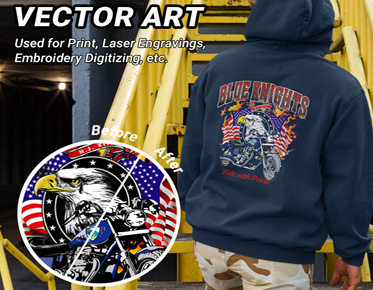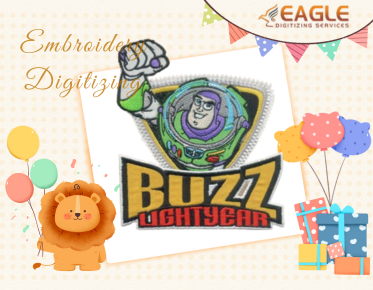Vector Art with GIFs: Can It Really Work?
When it comes to digital graphics, the choice of file format can significantly impact the final product. GIFs and vector art represent two different approaches to creating and displaying images. While GIFs have their own set of strengths, they aren't typically the first choice for vector art. Let's dive into why that is and explore the nuances of using GIFs in this context. If this post has captured your attention regarding raster to vector service and you want to learn additional information, feel free to reach us.
Understanding The Basics
What is a GIF?
GIF, short for Graphics Interchange Format, is a bitmap image format introduced by CompuServe in 1987. It's renowned for its ability to support simple animations and transparency. GIFs work by storing a sequence of images or frames in a single file, allowing for short, looping animations that can be easily shared and displayed on various platforms.
Key Differences Between GIF and Vector Formats
The fundamental distinction between GIFs and vector formats lies in their structure. GIFs are raster images composed of a grid of pixels, each assigned a color value. In contrast, vector formats, such as SVG and EPS, use mathematical equations to define shapes and lines. This difference means that while GIFs are fixed in resolution, vector graphics can be scaled to any size without losing quality.
The Nature of GIF Files
How GIF Files Work: A Technical Overview
GIF files operate by compressing image data using a lossless compression algorithm. Each frame of an animation is stored as a series of pixels, with the format supporting up to 256 colors per frame. This limitation is due to the 8-bit color depth of GIFs, which restricts the range of colors and can affect image quality.
Limitations of GIFs: Color Palette and Resolution
One of the main drawbacks of GIFs is their restricted color palette. With a maximum of 256 colors, GIFs are ill-suited for images requiring a wide range of hues and gradients. Additionally, since GIFs are raster-based, they are bound by a fixed resolution. Enlarging a GIF can result in pixelation and loss of detail, making it less ideal for high-quality graphics.
Common Uses for GIFs in Digital Media
GIFs are primarily used for simple animations, such as short loops or interactive web elements. They are popular for their ease of use and wide compatibility across web platforms. GIFs are also employed for basic graphics where high color depth and resolution are not crucial, such as small icons or social media reactions.
Why GIFs Aren’t Ideal for Vector Art
The Raster Nature of GIFs: Why It Matters
The raster nature of GIFs poses a significant challenge for vector art. Vector graphics are defined by mathematical equations that allow for scalable and editable images. GIFs, on the other hand, rely on a fixed grid of pixels, which means they cannot be resized or manipulated with the same flexibility. This lack of scalability is a major drawback when dealing with vector-based designs that require precision.
Loss of Quality: How GIFs Struggle with Scalability
When a GIF is scaled up, the pixelated nature becomes evident, leading to a loss of image clarity and detail. Unlike vector formats, which maintain sharpness at any size, GIFs become blurry and blocky when resized. This limitation makes GIFs unsuitable for applications where crisp, high-quality graphics are required.
Resolution Issues: The Pixelation Problem
Resolution issues are inherent in the GIF format due to its pixel-based structure. Enlarging a GIF file can result in noticeable pixelation, where individual pixels become visible and degrade the overall quality of the image. This problem is especially pronounced with intricate designs and detailed artwork, making GIFs a poor choice for high-resolution vector art.
Attempting to Use GIFs for Vector Art
Converting GIFs to Vector Formats: Is It Possible?
Converting GIFs to vector formats is technically possible but often impractical. The process involves tracing the pixel-based image to create vector paths, a task that can be challenging and time-consuming. The resulting vector file may not fully capture the original image’s detail, and manual adjustments are often required to achieve satisfactory results.
How GIFs Can Be Used as a Base for Vector Art
Despite their limitations, GIFs can serve as a starting point for vector art projects. Designers might use GIFs as reference images or to create rough sketches that are then traced and refined in vector editing software. This approach allows for the transformation of a simple GIF into a more versatile and high-quality vector graphic.
Tools and Techniques for GIF-to-Vector Conversion
Several tools and techniques can assist in converting GIFs to vector formats. Software such as Adobe Illustrator offers image tracing features that can help convert raster images into vector paths. Additionally, online converters can automate the process, though they may not always produce optimal results. Manual adjustments and refinements are often necessary to achieve the best outcome.
The Role of GIFs in Modern Design
GIFs in Motion Graphics and Animation
In modern design, GIFs play a significant role in motion graphics and animation. Their ability to create looping animations makes them ideal for short, engaging content that captures attention quickly. GIFs are frequently used in digital advertising, social media, and websites to convey simple messages or add dynamic elements.
Combining GIFs with Vector Art: Best Practices
Combining GIFs with vector art can enhance visual appeal and interactivity. Best practices include using GIFs for animated effects or small interactions while keeping the primary graphics in vector format. This approach ensures that the core design maintains high quality and scalability, while GIFs add dynamic elements without compromising overall design integrity.
Examples of Effective Use of GIFs in Design
Effective uses of GIFs in design include animated logos, interactive web elements, and attention-grabbing advertisements. For instance, a GIF might be used to animate a call-to-action button or to showcase a product feature in a brief, engaging manner. When used thoughtfully, GIFs can complement vector art and enhance user experience.
Alternative Formats for Vector Art
SVG: The Go-To Format for Vectors
Scalable Vector Graphics (SVG) is a preferred format for vector art due to its scalability and flexibility. SVG files use XML-based text to define shapes and paths, allowing for high-quality graphics that can be resized without losing detail. SVG is ideal for web design, interactive graphics, and any application requiring scalable and editable vector images.
EPS and PDF: Versatile Choices for Professional Use
Encapsulated PostScript (EPS) and Portable Document Format (PDF) are versatile formats used in professional design and printing. EPS files are commonly used for high-resolution print projects and support complex vector graphics. PDFs, while primarily a document format, can also contain vector graphics and are suitable for sharing and printing.
Comparing GIFs with Other Vector Formats
Compared to vector formats like SVG, EPS, and PDF, GIFs fall short in terms of scalability and quality. Vector formats are designed to maintain clarity and detail across various sizes and resolutions, whereas GIFs are limited by their pixel-based nature. For applications requiring precise and scalable graphics, vector formats are the superior choice.
When to Use GIFs Instead of Vector Art
Situations Where GIFs Excel: Short Animations and Simple Graphics
GIFs excel in scenarios where simple animations or basic graphics are needed. They are ideal for creating short, looping animations or interactive elements that do not require high resolution or extensive color depth. GIFs are particularly useful for web applications, social media, and digital advertising where quick, engaging visuals are beneficial.
Integrating GIFs into Vector-Based Projects
Incorporating GIFs into vector-based projects can add dynamic elements to an otherwise static design. For instance, a vector graphic might be enhanced with a GIF animation to draw attention or provide interactive feedback. This combination can create a visually compelling experience while leveraging the strengths of both formats.
How to Use GIFs to Complement Vector Art
To complement vector art with GIFs, focus on using GIFs for animated features or interactive components while keeping the main graphics in vector format. This approach allows you to maintain high quality and scalability for the core design while adding motion or interaction through GIFs. Ensure that the GIFs used are optimized for performance and do not detract from the overall quality of the vector artwork.
Challenges of Converting GIFs to Vector Formats
Software Tools for Conversion: What Works Best?
Several software tools can assist with converting GIFs to vector formats, including Adobe Illustrator, CorelDRAW, and various online converters. Adobe Illustrator’s image trace feature is particularly effective for converting raster images into vectors, though it may require manual adjustments to refine the results. Online converters can offer a quick solution but may lack the precision needed for high-quality vector graphics.
Maintaining Quality and Detail During Conversion
Maintaining quality during the conversion process can be challenging. To ensure the best results, use high-resolution GIFs and choose software that offers advanced tracing options. Be prepared to make manual adjustments to capture intricate details and avoid loss of quality.
Common Issues and How to Fix Them
Common issues during conversion include loss of detail, incorrect color reproduction, and inadequate scalability. Address these problems by carefully adjusting tracing settings, refining vector paths, and verifying the output in various sizes. Testing the converted file in different contexts can help identify and resolve any issues.
Best Practices for Using GIFs and Vector Art
How to Choose the Right Format for Your Project
Choosing the right format involves considering the specific needs of your project. For high-quality, scalable graphics, opt for vector formats like SVG or EPS. For simple animations or web elements, GIFs can be a suitable choice. Evaluate the requirements of your project to select the most appropriate format.
Balancing Quality and File Size
Balancing quality and file size is crucial for optimal performance. For vector art, ensure that your files are saved in a format that preserves detail and scalability without excessive size. For GIFs, optimize file size by reducing the number of colors and frames while maintaining acceptable quality.
Tips for Combining GIFs and Vectors Seamlessly
To combine GIFs and vectors seamlessly, integrate GIFs as supplementary elements rather than primary graphics. Use GIFs for animations or interactions while keeping the core design in vector format. Ensure that the GIFs are well-optimized and complement the vector artwork without overwhelming it.
While GIFs offer valuable functionality for animations and simple graphics, they are not ideal for high-quality vector art due to their raster-based nature and resolution limitations. For scalable and detailed vector graphics, formats like SVG, EPS, and PDF are more suitable. However, GIFs can still play a role in modern design when used thoughtfully, particularly for adding dynamic elements to vector-based projects. Understanding the strengths and limitations of each format will help you make informed decisions and achieve the best results for your creative endeavors.


